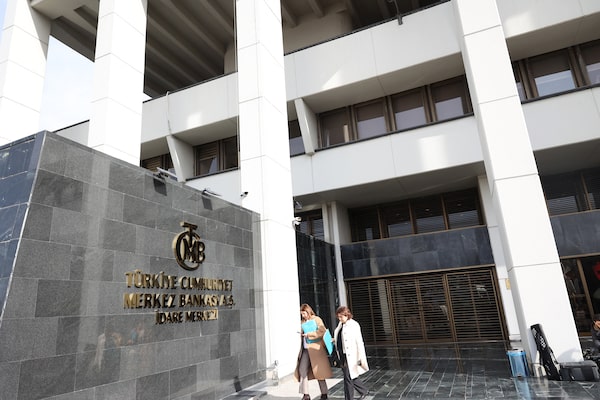
The Central Bank of Turkey, in Ankara, on Feb. 8. Turkey, whose debt is nearly half in foreign currency, offers bond yields of greater than 20 per centADEM ALTAN/Getty Images
The sovereign debt crisis that I and others have been warning about has yet to materialize, but it will eventually. These events are inevitable and more frequent than the public realizes. It’s the timing that’s extremely difficult to predict, as well as determining which countries will become ensnarled.
But that doesn’t mean all investors should stay clear of having exposure to bonds in emerging markets. With the right approach and risk tolerance, allocating a small weighting of one’s portfolio in countries with below-investment-grade credit ratings could be quite profitable.
Over the past two years, the world economy has experienced a dramatic rise in interest rates from historically unprecedented lows. Many countries with big debt loads have been in serious trouble and remain in a bad situation – Sri Lanka and Pakistan are two notable examples.
Because of the rapid increase in rates and the sheer amount of sovereign debt, there has never been so much owed in interest payments by the world’s countries.
So-called emerging nations are particularly hard hit as their economies and tax bases are small relative to their populations. It may be best not to think of all these countries as “emerging” in the first place because it implies these countries are transitioning to something better. Certainly, countries such as Poland, Hungary, Israel and South Korea have done very well growing their economies over the years, but many others have not and will continue to struggle.
Sovereign debt is defined as debt issued by an independent political entity, be they U.S. Treasuries, Government of Canada bonds or debt issued by any country. Richer countries, such as the U.S. and Canada, issue almost all of their debt in their own currency. Consequently, they can always print more of their currencies to make their coupon payments and roll over their maturing instruments. Of course, printing too much money has dire consequences, such as high inflation and a disruption of efficient capital allocation, but an outright default is improbable. As a result, they have a propensity to inflate away their debt issues.
Former BoC governor Mark Carney warns of ‘slower and shallower’ rate cuts
Poorer countries, with more volatile and less evolved economies that are more vulnerable to inflation, need to issue debt in U.S. dollars or some other stable currency because investors have little idea how much the country’s currency will be worth in the future.
Turkey, whose debt is nearly half in foreign currency, offers bond yields of greater than 20 per cent, which would seem to make it a screaming buy. However, at a current annual inflation rate of 67 per cent, that might not seem like such a great deal. Also, President Recep Tayyip Erdogan seems intent on his country leaving the West and becoming a leader of the anti-Western alliance with Iran, Russia, and China. Consequently, there are legitimate creditworthiness issues with respect to Turkey and other countries.
A country that borrows in a foreign currency such as the U.S. dollar or euro needs to have enough foreign-exchange reserves to make its payments. If its currency is falling, acquiring reserves can be difficult. That is usually how these countries get into trouble. Then it’s off to the World Bank, International Monetary Fund and private bankers to renegotiate terms and for investors to take haircuts on their initial investments. This is the nature of risk. These markets pay higher rates because of the higher probability that they will renege.
It’s not easy to pick the countries susceptible to default because one cannot go just on raw data. Some countries default while having smaller amounts of foreign denominated debt per capita than others that merrily survive. Some countries and individual leaders are more likely to default than others. Greece has defaulted five times since it achieved independence in 1830. Lebanon, Sri Lanka, Russia, Suriname and Zambia are currently in default and the number will grow.
Investors need to think long term. Sovereign debt crises come and go and the world marches on. Some countries have bonds that have seen their yield spreads widen dramatically relative to U.S. Treasuries, such as Turkey’s, while India and others have narrowed.
However, many Canadian investors might be surprised at how well emerging market debt has done as an asset class. For the 10 years ended Feb. 29, the J.P. Morgan USD Emerging Market Index returned 2.85 per cent, annualized on a total return basis. Not great, but better than the 1.25-per-cent returns for the benchmark for U.S. Treasuries. For the 12-month period ended Feb. 29, emerging debt returned 9.67 per cent, compared with U.S. Treasuries at 3.87 per cent.
Over the past few decades, emerging market debt has performed relatively well, albeit with some downdrafts.
There should be little doubt that the world has entered a volatile period, and more countries will enter the failed-state category.
However, a well-diversified ETF like the iShares J.P. Morgan USD Emerging Markets Bond ETF probably merits some attention. Spreads are thin, with its current yield of 6.87 per cent – only 2.34 percentage points above U.S. Treasuries – as the market seems to be pricing in better economic times ahead. But there could be opportunities later this year if spreads start to widen.
Also, take note: Countries that probably will run into problems are not big weights in most emerging market credit ETFs and indices. In the JPMorgan ETF, Turkey is the biggest holding, but only with 4.27-per-cent weighting as of March 31.
Tom Czitron is a former portfolio manager with more than four decades of investment experience, particularly in fixed income and asset mix strategy. He is a former lead manager of Royal Bank of Canada’s main bond fund.